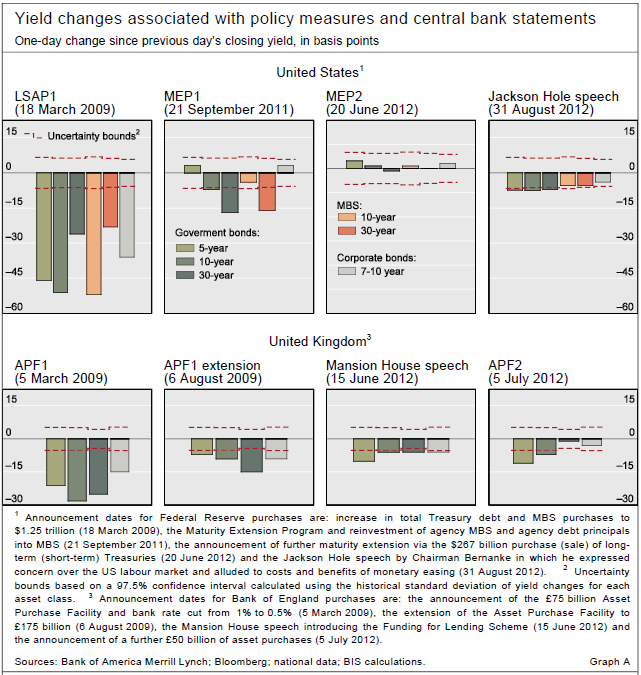Unconventional policies: market impact and countervailing factors
(Extract from pages 6-7 of BIS Quarterly Review, September 2012)
Central bank asset purchases can affect credit growth and real activity through a variety of channels.1 Policy transmission begins with market reactions to official statements or anticipations thereof. The mere announcement of asset purchases can signal commitment to monetary stimulus, thereby lowering the expected path of future short-term rates (signalling channel). In addition, central banks can remove duration from the market through purchases of longer-term securities. This will lower longer-term yields, inducing investors to rebalance their portfolios towards assets with greater risk (portfolio rebalancing channel). While such portfolio rebalancing takes time, in forward-looking markets the central bank's commitment to purchases alone can trigger portfolio adjustments. Further, if asset purchase programmes are anticipated, investors will price them in even before the specifics are announced. As a result, policy announcements will affect yields only if they deliver an additional element of "surprise" to the market.
Unconventional asset purchase measures were typically first introduced during the crisis management stage, when the solvency and liquidity of major financial institutions hung in the balance.2 Yet, as the focus shifts to economic recovery, at least outside the euro area, this has raised questions about diminishing market reactions to further extensions of such purchases.
A comparison of yield changes on key assets at the time of past programme announcements with more recent ones suggests that the announcement effects of asset purchase programmes have waned. Yields on Treasury securities, mortgage-backed securities (MBS) and corporate bonds hardly moved on 20 June 2012, when the Federal Reserve announced the extension of the maturity of its Treasury portfolio (Graph A). In contrast, the September 2011 announcement of the initial Maturity Extension Program (MEP1), along with further purchases of MBS, coincided with immediate declines in long-term yields of Treasuries and MBS. Furthermore, the announcement of the first round of Large-Scale Asset Purchases (LSAP1) back in 2009 was associated with significantly larger declines in Treasury yields across all maturities, ranging from 26 to 51 basis points. Similarly, the response of gilt yields to the Bank of England's expansion of its Asset Purchase Facility (APF2), while still significant for five- and 10-year maturities, has been muted compared to the introduction of the programme back in March 2009.
A variety of factors may explain these patterns. First, the novelty and surprise element of asset purchase measures may have waned. In this case, changes in asset prices on announcement days may understate the overall market impact since investors may have learned to anticipate them. As a result, greater announcement impact may now come from less anticipated statements and policy innovations, such as when the Bank of England announced the Funding for Lending Scheme.
Second, with policy rates close to zero, it is unlikely that asset purchase measures would lower expectations of future interest rates any further by signalling the future policy stance. This is especially true in countries where central banks have been complementing asset purchase policies with explicit signals that future short-term risk-free rates would remain low. For example, the Federal Reserve's forward guidance on keeping interest rates low for an extended period may have firmly anchored expectations of future short-term rates.
Third, despite central bank purchases, the maturity of outstanding public debt has continued to increase. For example, despite the Federal Reserve's purchases, the cumulative public holdings (ie excluding the Federal Reserve) of Treasury debt with a maturity of one year or more have risen by approximately $3 trillion since the beginning of 2009 and their average maturity has risen from about 50 to 60 months. Hence, in order to have the same duration impact, central banks may have to increase the maturity of their Treasury holdings at an even higher rate. Such diminishing duration impact per dollar of purchases going forward may also be reflected in a lower market impact on announcement.
Finally, negative term premia imply that the margin of adjustment for long-term yields has diminished further (Graph 4). This would impede the portfolio rebalancing channel because when the central bank removes duration from the Treasury market, the reduction in yields on other assets comes primarily through a narrowing in their risk premia. For long-term assets, the main component would have been the term premium. In addition, when the solvency and liquidity of major financial institutions hung in the balance in 2009, credit and liquidity risk premia would have been affected as well. By now, however, the scope for affecting these components of the risk premium, and hence for lowering yields across asset classes, has diminished.
1 For announcement effects, see eg J Meaning and F Zhu, "The impact of Federal Reserve asset purchase programmes: another twist", BIS Quarterly Review, March 2012, pp 23-32; and M Bauer and G Rudebusch, "Thesignaling channel for Federal Reserve bond purchases", FRBSF Working Paper Series, no 2011-21, December 2011.For the portfolio balance channel, see J Gagnon, M Raskin, J Remache and B Sack, "The financial market effects of the Federal Reserve's large-scale asset purchases", International Journal of Central Banking, vol 7(1), March 2011,pp 3-43. Irrespective of the transmission channel, there is strong evidence of the effectiveness of asset purchases since 2009; see eg S D'Amico and T King, "Flow and stock effects of large-scale Treasury purchases: evidence on the importance of local supply", Federal Reserve Board Finance and Economics Discussion Series, working paperno 2012-44, February 2012.
2 Further, central bank balance sheet measures adopted in the wake of the global financial crisis provided temporary support to economic activity and consumer prices. See L Gambacorta, B Hofmann and G Peersman, "The effectiveness of unconventional monetary policy at the zero lower bound: a cross-country analysis", BIS Working Papers, no 384, August 2012.



